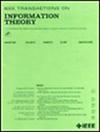On Low-Power Error-Correcting Cooling Codes With Large Distances
IF 2.2
3区 计算机科学
Q3 COMPUTER SCIENCE, INFORMATION SYSTEMS
引用次数: 0
Abstract
A low-power error-correcting cooling (LPECC) code was introduced as a coding scheme for communication over a bus by Chee et al. to control the peak temperature, the average power consumption of on-chip buses, and error-correction for the transmitted information, simultaneously. Specifically, an大距离低功耗纠错冷却码研究
Chee等人提出了一种低功耗纠错冷却码(LPECC)作为总线通信的编码方案,可以同时控制芯片上总线的峰值温度、平均功耗和传输信息的纠错。具体来说,$(n, t, w, e)$ -LPECC代码是一种基于n条线的编码方案,它避免了t条最热的线上的状态转换,并且在每次传输中最多允许w个状态转换,并且可以纠正多达10个传输错误。在本文中,我们研究了$(n, t, w, e)$ -LPECC代码的最大可能大小,用$C(n,t,w,e)$表示。当$w=e+2$较大时,建立一般上界$C(n,t,w,w-2)\leq \lfloor \binom {n+1}{2}/\binom {w+t}{2}\rfloor $;当$w=e+2=3$,我们证明$C(n,t,3,1) \leq \lfloor \frac {n(n+1)}{6(t+1)}\rfloor $。两个边界对于满足某些可整除条件的大n都是紧的。以前,只有$w=e+2=3,4$和$t\leq 2$才知道紧密边界。一般情况下,对于常数d,当$w=e+d$很大时,我们确定了$C(n,t,w,w-d)\sim \binom {n}{d}/\binom {w+t}{d}$在n趋于无穷时的渐近值,可以推广到q元码。
本文章由计算机程序翻译,如有差异,请以英文原文为准。
求助全文
约1分钟内获得全文
求助全文
来源期刊

IEEE Transactions on Information Theory
工程技术-工程:电子与电气
CiteScore
5.70
自引率
20.00%
发文量
514
审稿时长
12 months
期刊介绍:
The IEEE Transactions on Information Theory is a journal that publishes theoretical and experimental papers concerned with the transmission, processing, and utilization of information. The boundaries of acceptable subject matter are intentionally not sharply delimited. Rather, it is hoped that as the focus of research activity changes, a flexible policy will permit this Transactions to follow suit. Current appropriate topics are best reflected by recent Tables of Contents; they are summarized in the titles of editorial areas that appear on the inside front cover.
 求助内容:
求助内容: 应助结果提醒方式:
应助结果提醒方式:


